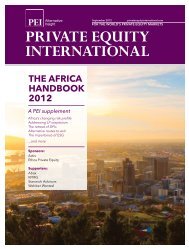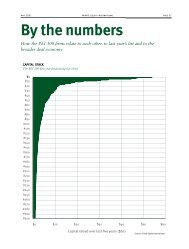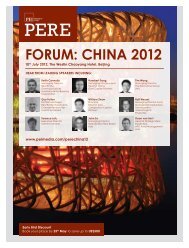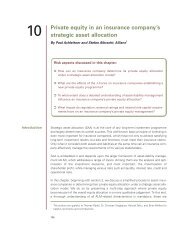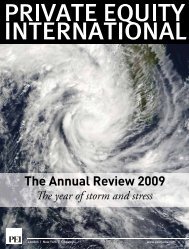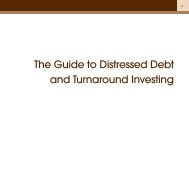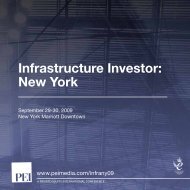THE ANNUAL REVIEW 2010 - PEI Media
THE ANNUAL REVIEW 2010 - PEI Media
THE ANNUAL REVIEW 2010 - PEI Media
Create successful ePaper yourself
Turn your PDF publications into a flip-book with our unique Google optimized e-Paper software.
private equity annual review <strong>2010</strong> pa g e 93<br />
JUNE<br />
What’s behind the recent spike in exits?<br />
“Deals are the privilege of the funded. A<br />
private equity firm that fails to raise the<br />
next fund ceases to exist (although its<br />
end-of-life period is impressively protracted).<br />
A private equity firm that fails<br />
to raise the right size of fund becomes<br />
a different firm, with fewer people and<br />
fewer offices by dint of a smaller income.<br />
It’s a disruptive step down. This analysis<br />
is worth bearing in mind as sprouts<br />
and blossoms begin to appear across the<br />
frozen tundra of the deal market. Transactions<br />
are indeed beginning to happen,<br />
but GPs appear to be hugely focused on<br />
scoring exits. A cynic would say that some<br />
of these exits have been put on the fast<br />
track in order to ensure a more successful<br />
follow-on fundraising in the near future.”<br />
JULY/AUGUST<br />
On research into style drift<br />
“Confirming conventional wisdom, those<br />
firms that had been prodigious adders of targeted industries<br />
over the prior five years had a lower average performance over<br />
the subsequent years. And in a finding that will no doubt delight<br />
specialist firms, those GP groups that had diversity scores near<br />
1 (in other words, no industry diversity) tended to be the best<br />
performers. Overall, Gottschalg says his research confirms that<br />
‘it’s really good if you’re focused. It’s harder to be unfocused,<br />
and if you recently became unfocused, that’s the most difficult’.”<br />
SEPTEMBER<br />
On succession in private equity<br />
“One doesn’t often hear the term ‘retirement’ in private equity,<br />
at least not in the US. While a number of big-time hedge fund<br />
managers have announced their retirements in recent years, it<br />
is hard to think of any private equity founders who have simply<br />
walked away from the job. More often, these founders hold forth<br />
the promise of long (or excruciatingly long) succession plans, or,<br />
in too many cases, have no succession plans, somehow believing<br />
their investors will have no opinion about committing capital to<br />
a ten-year fund under the iron rule of a septuagenarian.”<br />
OCTOBER<br />
The finer points of LP co-investment<br />
“The vast majority of co-investment deals made available to limited<br />
partners – either directly from GPs or through third-party coinvestment<br />
programme administrators – have been in what could<br />
be defined as the ‘mega/large’ size category. This is perhaps not<br />
surprising – large deals require more equity, and therefore GPs<br />
“A GP doesn’t score<br />
many points by arguing<br />
that the management<br />
fee should be a wealth<br />
creator”<br />
are more likely to give LPs the opportunity<br />
to pony up additional cash. But there is at<br />
least one problem with this from the LP’s<br />
point of view. If it is accepted that the largest<br />
deals will tend to be the ones that are<br />
offered to LPs as co-investment opportunities,<br />
LPs should not necessarily want to<br />
inject further capital into deals to which<br />
they are already highly exposed. It could<br />
be that the benefit of reduced average fees<br />
for ownership of an asset is offset by the<br />
effect that increased ownership of the asset<br />
has on the diversity of the larger portfolio.”<br />
NOVEMBER<br />
How hold-at-cost valuation exaggerates<br />
performance numbers<br />
“End-to-end performance averages measure<br />
backwards over a specified time span<br />
to starting points populated by funds that<br />
are understating the fair value of their<br />
portfolio companies. The further back<br />
you go, the more pronounced the effect<br />
is. This problem goes away when viewing<br />
private equity fund performance through the prism of vintage<br />
years, which have long been thought of as the most useful way<br />
to think about returns. But in seeking to compare private equity<br />
to other asset classes, the time-horizon approach has frequently<br />
been used, often with the result of private equity appearing to<br />
be quite attractive indeed. As institutional investors learn more<br />
about how private equity has truly behaved over the years as an<br />
asset class, they won’t necessarily fall out of love with it, but<br />
they will likely wake up to the realisation that it’s harder work<br />
than anyone heretofore led them to believe.”<br />
DECEMBER/JANUARY<br />
Snow on Snow – the editor-at-large grades his predictions<br />
one year on<br />
“‘US public pensions will fade as a source of capital’. You now<br />
need to register as a lobbyist if you want to raise money from<br />
California institutions, thanks to the pay-to-play scandal. More<br />
broadly, US pensions are expected to continue to face tremendous<br />
pressure going forward. It is unclear what this means for their<br />
private equity allocations, but for the time being most of these<br />
very large LPs remain committed and solvent. Verdict: maybe<br />
not. ‘The public private equity firm will win fans’. It is clear that<br />
many more private equity firms will go public as soon as they<br />
have the chance. But few of these will remain pure-play direct<br />
private equity investors, as KKR’s radical business diversification<br />
indicates. These listings will be greeted warmly by investors, by<br />
the selling GPs, and by the firm employees who get a piece of<br />
the action, if not by LPs. Verdict: probably true.” ■




